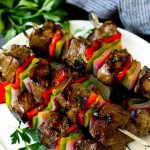 A method of cooking developed by Nomadic sheep herdsmen in the Near East who found that they could roast lamb or mutton over their campfire by cutting the meat into small pieces and thrusting it onto a skewer and cooked over the fire. The Shish means “skewer” and Kebab means “roast meat.” In Russia it’s called Shashik and in France it’s called en Brochette.
A method of cooking developed by Nomadic sheep herdsmen in the Near East who found that they could roast lamb or mutton over their campfire by cutting the meat into small pieces and thrusting it onto a skewer and cooked over the fire. The Shish means “skewer” and Kebab means “roast meat.” In Russia it’s called Shashik and in France it’s called en Brochette.
Made by sliding chunks of mutton onto a skewer and then grilling them over embers, the shish kebab takes its name from the Turkish shish, meaning skewer, and kebap, meaning roast meat. When the mutton is sliced and then wrapped with herbs around a rotating, vertical skewer it is called a doner kebab, the word doner being Turkish for turning. Of these two terms, shish kebab is older, first appearing in English in the second decade of the twentieth century, about forty years before the appearance of doner kebab in the late 1950s (doner kebab is often shortened to doner, which in turn is sometimes respelt as donair). Adopted much earlier was the word kebab itself, used in English since the late seventeenth century but until the end of the nineteenth century usually spelt cabob.
Kebabs are small cubes of meat that are skewered and roasted over an open flame. They are often cooked alongside mushrooms, tomatoes, onions, and other ingredients.
In its truest form, a kebab refers to a portion of meat. However, when the term “kebab” is commonly used, it generally refers to the popular dish known as Shish Kebab. Originating from the Orient, particularly Turkey and other Arabic countries, Shish Kebab consists of small cuts of meat, often lamb or mutton, threaded onto skewers and then grilled. In the Russian version called Shashlik, beef is typically used instead. The meat is well-seasoned and sometimes marinated prior to cooking. It may also be accompanied by a variety of ingredients such as onions, mushrooms, tomatoes, peppers, and more, adding extra flavor and texture to the dish.
